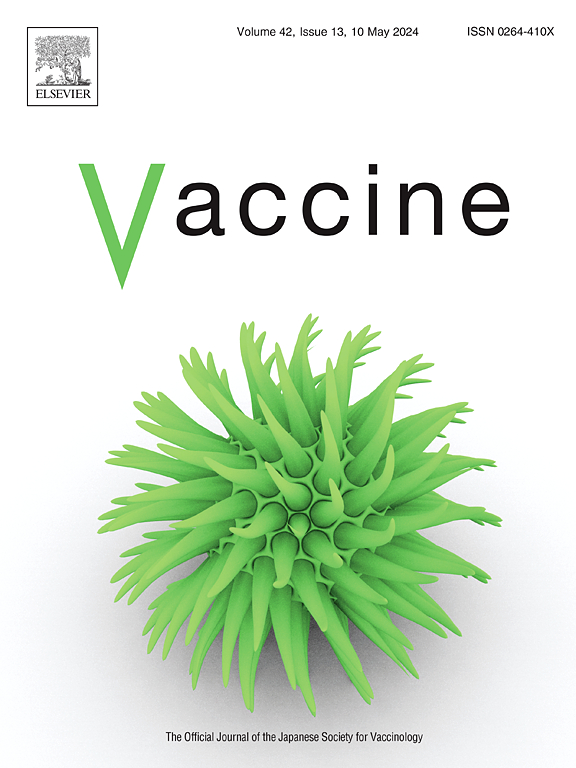暴露前预防艾滋病毒感染人群初次接种乙型肝炎疫苗后的长期保护和对加强剂量的反应
IF 4.5
3区 医学
Q2 IMMUNOLOGY
引用次数: 0
摘要
背景:意大利于1991年开始普及乙型肝炎病毒(HBV)疫苗接种。然而,疫苗引起的保护的长期持久性仍然存在争议,特别是在使用艾滋病毒暴露前预防(PrEP)的男男性行为者(MSM)等高危群体中。本研究旨在评估MSM-PrEP使用者在婴儿免疫后近30年对加强疫苗的HBV血清保护和免疫反应。这项回顾性研究包括2017年至2024年间在意大利米兰使用PrEP的35岁以下意大利男男性接触者。方法在PrEP开始时测定HBsAb血清学状态,HBsAb水平低于10 mIU/mL的参与者给予加强剂量。根据血清保护状态和增强反应进行统计学分析,比较人口学和临床变量。结果在447名使用PrEP的MSM中,271人(60.6%)HBsAb水平≥10 mIU/mL, 176人(39.4%)在PrEP开始时HBsAb水平≥10 mIU/mL。血清保护在年龄较大(p = 0.014)和AST水平较高(p = 0.019)的参与者中更为普遍。在接受强化疫苗的55/176名参与者中,38人(69.1%)出现保护性HBsAb水平。强化前HBsAb水平在2 - 9.9 mIU/mL之间与更好的强化应答相关(p = 0.032)。结论:近40%使用PrEP的男男性接触者在初次接种HBV疫苗30年后缺乏保护性HBsAb,约三分之一的强化接种者未能应答。由于这一群体的高风险性质,建议系统的HBsAb筛查和加强给药,以确保充分的保护。本文章由计算机程序翻译,如有差异,请以英文原文为准。
Long-term protection and response to a booster dose after primary hepatitis B vaccination in people under pre-exposure prophylaxis for HIV infection
Background
Universal hepatitis B virus (HBV) vaccination was introduced in Italy in 1991. However, the long-term durability of vaccine-induced protection remains under debate, particularly among high-risk groups such as men who have sex with men (MSM) using HIV pre-exposure prophylaxis (PrEP). This study aimed to assess HBV seroprotection and the immune response to a booster vaccine nearly 30 years after infant immunization among MSM-PrEP users.
Setting
This retrospective study included Italian MSM using PrEP under 35 years of age in Milan, Italy, between 2017 and 2024.
Methods
HBV serological status was determined at the start of PrEP. Participants with HBsAb levels below 10 mIU/mL were offered a booster dose. Statistical analyses were performed to compare demographic and clinical variables according to seroprotection status and booster response.
Results
Overall, among 447 MSM using PrEP, 271 (60.6 %) had HBsAb levels ≥10 mIU/mL, while 176 (39.4 %) <10 mIU/mL at the start of PrEP. Seroprotection was more prevalent among older participants (p = 0.014) and those with higher AST levels (p = 0.019). Of the 55/176 participants who received a booster, 38 (69.1 %) developed protective HBsAb levels. Pre-booster HBsAb levels between 2 and 9.9 mIU/mL were associated with a better booster response (p = 0.032).
Conclusions
Almost 40 % of MSM using PrEP lacked protective HBsAb three decades after primary HBV vaccination, and around one-third of booster recipients failed to respond. Due to the high-risk nature of this group, systematic HBsAb screening and booster administration are recommended to ensure adequate protection.
求助全文
通过发布文献求助,成功后即可免费获取论文全文。
去求助
来源期刊

Vaccine
医学-免疫学
CiteScore
8.70
自引率
5.50%
发文量
992
审稿时长
131 days
期刊介绍:
Vaccine is unique in publishing the highest quality science across all disciplines relevant to the field of vaccinology - all original article submissions across basic and clinical research, vaccine manufacturing, history, public policy, behavioral science and ethics, social sciences, safety, and many other related areas are welcomed. The submission categories as given in the Guide for Authors indicate where we receive the most papers. Papers outside these major areas are also welcome and authors are encouraged to contact us with specific questions.
 求助内容:
求助内容: 应助结果提醒方式:
应助结果提醒方式:


